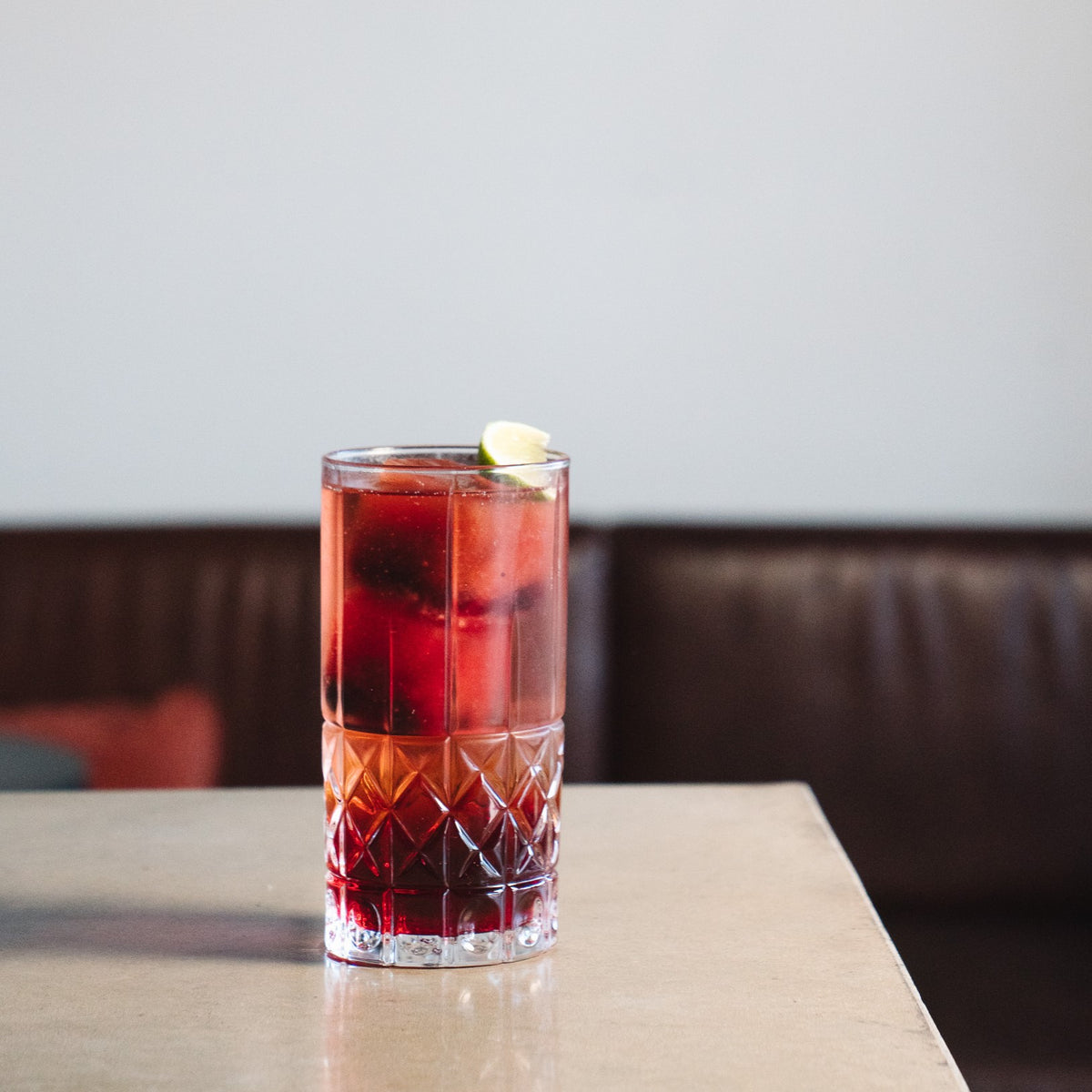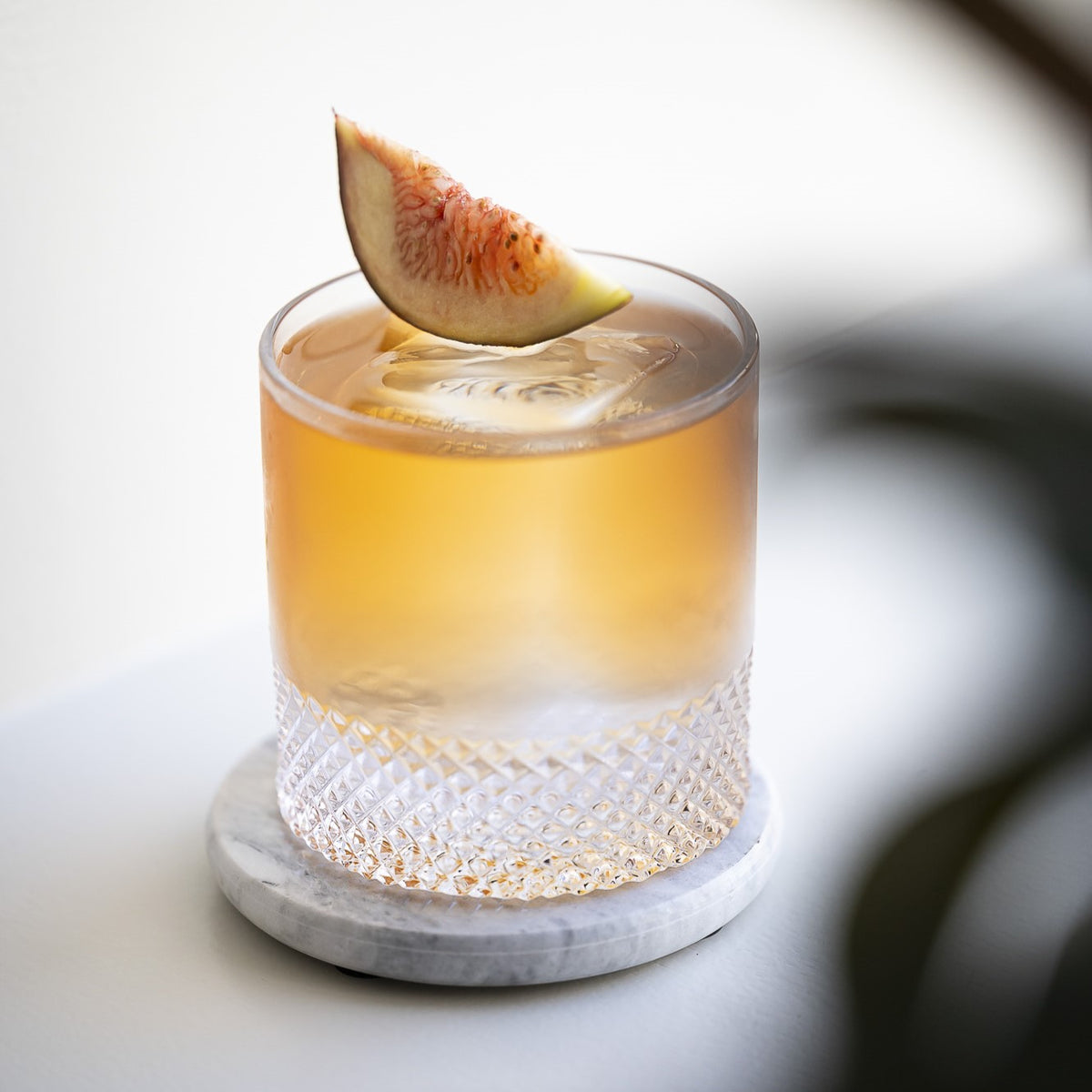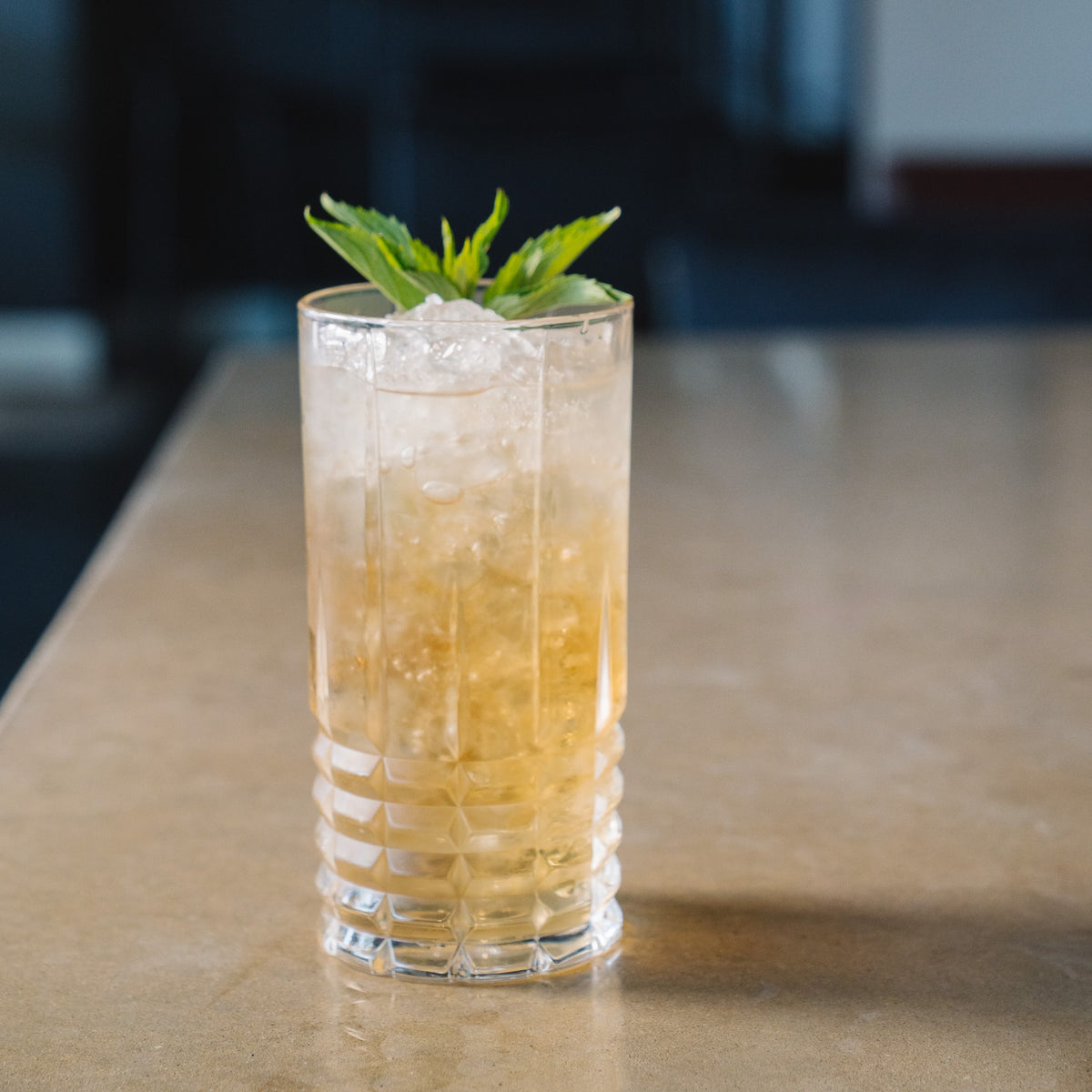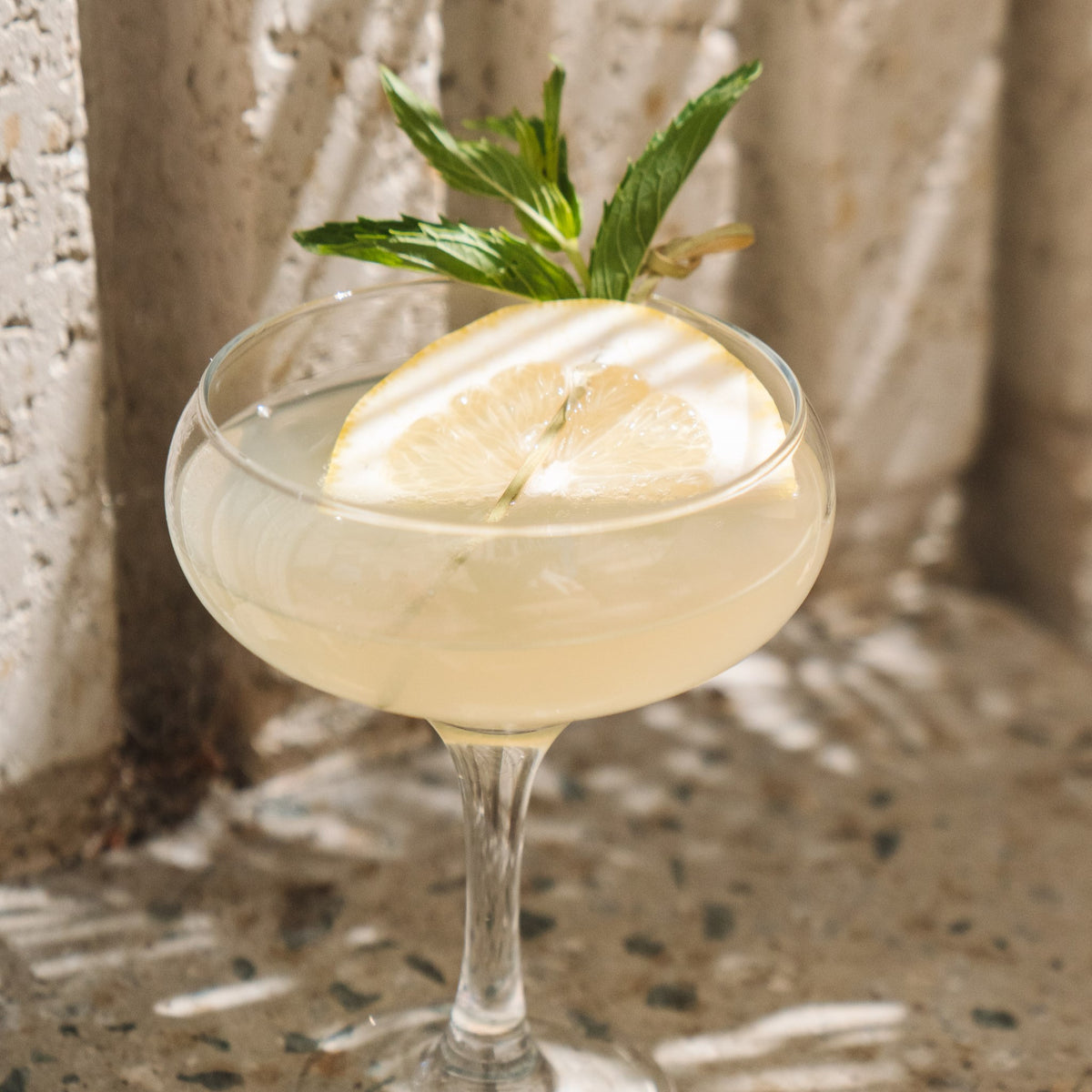Wedges are used in muddling recipes to extract maximum juice from the pulp, and also oils from the skin. In a tall mixed drink, the wedge of citrus will have a strong influence. Be sure to remove the seeds if using a wedge cut when muddling.
Wedges are used in muddling recipes to extract maximum juice from the pulp, and also oils from the skin. In a tall mixed drink, the wedge of citrus will have a strong influence. Be sure to remove the seeds if using a wedge cut when muddling.
Bitters are an aromatic and intense seasoning made of various roots, barks, herbs, spices and botanicals. There are many great producers of bitters, some using alcohol as a base and others not, with many different flavourings and inspirations. The application to a recipe, adds a distinct punch and extra dimension of flavour.
A thin wheel of citrus in a drink can offer multiple flavours, as the liquid can encounter the skin, pith and juice, each of which delivers a unique combination of oils, sugars and acids.
A thin wheel of citrus in a drink can offer multiple flavours, as the liquid can encounter the skin, pith and juice, each of which delivers a unique combination of oils, sugars and acids.
Spearmint, commonly referred to as mint, has been documented from the beginning of the first century AD, and used throughout history in medical applications, antioxidants, decorative applications and beverages. Mint comes in many varieties which have different nuances, offering fresh aromatics and a cooling sensation on the palate. Other varieties of mint to try as a garnish include Peppermint, Apple Mint and Chocolate Mint. Before using, firmly slap mint leaves on the back of your hand. This releases the oils, making the leaves more aromatic.
A thin slice of citrus skin, with an even skin to pith ratio. The pith will give the garnish structure and the drink bitterness.
Flamed zest is most commonly done with orange, however most citrus can be used. The oils from the zest pass through the open flame into the drink adding a smoky complexity.
A wider cut than the twist, the peel is squeezed over finished drinks to extract the natural flavours and oils. A correctly prepared zest should have more skin than pith.
A thin wheel of citrus, halved to resemble a semi-circle.
Historically used as an ornamental plant in royal households, rosemary is considered one of the easiest herbs to manage and maintain. Rosemary offers a woody, peppery flavour profile, and brings an additional savoury quality and slight bitterness on the palate. Due to its robust nature, rosemary can also be burnt, changing the flavours as a garnish or incorporating smoke into a recipe or finished drink. If nurtured, a single pot of rosemary can survive for many years. Prune your plant often, as it will become denser over time.
Bay leaf is used in a wide range of cuisines around the world, and many of its characteristics can change depending on its species and country of origin. It can be used fresh, dried or ground into a powder. Its application in beverages is mainly for its aromatic attributes, giving drinks a perfumed freshness and savoury lift. For garnishes, fresh bay leaf will provide the best results, whilst dried can be used in syrups or infusions.
Kaffir lime originates from south east Asia, where it is a focal ingredient in many dishes. It is categorized by intense and uplifted savoury flavours with citrus undertones. Kaffir lime is still used in medical practices due to its antioxidant properties. Lightly press the leaves against chopping board to release oils and flavours.
Cinnamon, or ‘true cinnamon’ is native to India, Sri Lanka and Bangladesh. It was transported by spice traders to Egypt and Greece and used in a variety of rituals including embalming and anointing oils. Cinnamon has a warm, layered and slightly spiced aromatic profile. On the palate, it has strong savoury characters and, in some instances, gives the sensation of ‘tannin’. Cinnamon can be used as a garnish, as an ingredient in syrups, and can be blended directly into sugars and seasonings. Store in a cool dark place, under airlock.
Basil is famed for its pungent aromatics and sweet aniseed flavour profile and is thought to be the base of ancient perfumes. Classified as a tender herb, basil should be handled delicately once harvested. As a garnish, its aromatics lift, and when mixed as an ingredient it offers a distinct freshness. Other varieties of basil to experiment with include Thai Basil, Holy Basil and Lemon Basil. Before using, gently slap basil leaves on the back of your hand. This releases the oils, making the leaves more aromatic.
Spearmint, commonly referred to as mint, has been documented from the beginning of the first century AD, and used throughout history in medical applications, antioxidants, decorative applications and beverages. Mint comes in many varieties which have different nuances, offering fresh aromatics and a cooling sensation on the palate. Other varieties of mint to try as a garnish include Peppermint, Apple Mint and Chocolate Mint. Before using, firmly slap mint leaves on the back of your hand. This releases the oils, making the leaves more aromatic.
Historically, dill had many uses. It has been documented in ancient Egyptian medical texts and was also used as a symbol of wealth. Characterized by a unique and distinguishable flavour set, both its leaves and seeds are used. Dill leaves have fragrant aniseed and herbal notes. As a garnish, it works well in drinks that are of a lighter, fresher nature and contrasts citrus flavours with cool vegetal crispness. Because of its forward flavour be conservative when using dill as a garnish, as a small amount has a big impact.
Bitters are an aromatic and intense seasoning made of various roots, barks, herbs, spices and botanicals. There are many great producers of bitters, some using alcohol as a base and others not, with many different flavourings and inspirations. The application to a recipe, adds a distinct punch and extra dimension of flavour.
Thyme has had various uses throughout history. During the European middle ages, it was placed under the pillow to aid in a good night’s sleep. Thyme has a delicate, subtle flavour of lemon and aniseed with slight earthy tones. As a garnish it adds a pleasant perfumed aromatic lift, and a subtle savoury characteristic on the palate. Once harvested, thyme will start to deteriorate rapidly so it is best used when picked, however it can freeze well for months on end.
Lemongrass has a long and established link to the cuisines of South East Asia as a pillar ingredient in many regional dishes, and historically used in herbal teas, remedies and essential oils. Lemongrass provides a floral and herbal lift. Its spicy undertones, similar to ginger, make lemongrass and ginger such a well-matched combination. To prepare lemongrass, cut top and base, lay the stalk flat and crush to disconnect the fibers and release the flavours. Select lemongrass with a firm stalk and distinguished, bright colours, as this is an indication of freshness.
Chilli peppers are part of the capsicum family and were one of the first plants to be cultivated. Originating in what is now Mexico, and with thousands of species around the world and an infinite way in which they are used, we encourage you to experiment with the varieties you have available to your taste. Chillies can be served fresh, brined, pickled or dehydrated. As a garnish they provide an impressive visual impact and are dynamic in their flavour delivery. Generally, the smaller the chilli, the more heat it will produce.
Cloves are aromatic flower buds, native to Indonesia but now grown throughout the world. Used in traditional medical practices, and also in modern aromatherapy, cloves are characterized by their pungent aroma and rich, spicy and astringent flavour. Cloves are best used as a garnish in drinks that are served warm, to allow the aromatics to carry in the steam. They pair well with lemon and orange, as the flavours contrast nicely, and are an excellent combination with nutmeg and cinnamon. Cloves are very intense, be conservative when using them for the first time.
The highball glass takes its name from the whiskey and soda cocktail. The highball glass is a sturdy, tall tumbler, used for serving drinks with a high quantity of ice and mixer. The glass allows for the drink to stay cold, and its small circumference maintains carbonation for longer periods. It is mainly used for brown spirits, distillations, and liquors – served with a mixer. It is also a nice glass for tall drinks that require crushed ice, or tall, built drinks.
This has the same technical attributes as the rocks glass however, its larger size means it is perfect for recipes with a high level of residual ingredients.
The rocks glass, also known as a lowball or old fashioned, is a short tumbler used for serving drinks neat or over ice. Its relatively short height and wide circumference allows for an easy release of aromatics. It is also used for more forward cocktail recipes.
The Collins glass is similar in appearance to the highball glass however, it is taller and with a smaller circumference. It is also primarily used for tall, built drinks and mainly reserved for white spirits and distillations that are lighter and more fragrant than their brown counterparts. The smaller circumference allows for the aromatics to be captured, and the carbonation of a mixer to be preserved.
The coupe was originally designed as a vessel for champagne however, it has been adopted by bartenders as an alternative shape to the martini glass to serve cocktails. The modern cocktail coupe is now quite different from its original conception, having slightly higher walls and a smaller circumference.
The original design of this vessel hails from Moscow but was made famous in California in 1941. It was designed specifically using copper, allowing the material to act as a thermal conductor and keeping the contents of the drink colder than other materials. This is especially handy for recipes with crushed ice, as the smaller ice particles can remain solid for longer periods of time.
The original design of this vessel hails from Moscow but was made famous in California in 1941. It was designed specifically using copper, allowing the material to act as a thermal conductor and keeping the contents of the drink colder than other materials. This is especially handy for recipes with crushed ice, as the smaller ice particles can remain solid for longer periods of time.
This shape is for pure drinks. While other shapes have the flexibility to have ice added, the Nick and Nora is designed exclusively for drinks that are ‘served up’ – without ice. The design of the Nick and Nora follows the basic template of the cocktail, martini and coupe glasses. It is used for stirred drinks.
The purpose of the conical sieve is to ‘double strain’ cocktails. The conical sieve collects any ice fragments or ingredient particles to ensure a clear drink.
Cocktail shakers come in two general types: Boston Shakers or Cobbler Shakers, and are used to combine ingredients of a cocktail by shaking over ice.
Although similar to the martini glass, the cocktail glass is slightly shorter and smaller. It was invented initially to ensure that drinks ‘served up’ – without ice, maintained their chilled temperature as the glass was not warmed by the heat of the hand.
The shot glass has historically been used as both a measuring vessel and as a serving glass. It is perfect for individual serves of spirits and distillations and can be used to serve Espresso. This glass is ideal for powerful recipes of small quantity with no ice. It can also double as a jigger in the home bar.
Associated with the classic martini cocktail, the martini glass was invented following the recipe’s creation. Prior to this, the martini was served in a cocktail glass. As the martini gained momentum, the shape of the cocktail glass was altered to suit the newly popular cocktail. It became larger to accommodate garnishes and also to give a wider surface area to the aromatics. And thus, the martini glass was born. The martini glass is used in many recipes that are ‘served up’ – without ice.
The dry white wine glass allows for the delivery of delicate aromatics and is generally used for lower alcohol white wines. Its widened base and narrowed rim encapsulate the aromatic experience. It is a great vessel for built drinks that have a carbonated mixer, or sparkling wine and enables garnishes to be layered over ice for great visual effect.
The aromatic red wine glass highlights drinks with forward aromatics and flavours. It is perfect for serving bold, refreshing cocktails. This glass has the benefit of a stem, meaning the drink will not be warmed from the heat of the hand, and also allows for a large proportion of ice which maintains a cool temperature. The larger shape also gives room for plentiful garnish.
Cocktail strainers are used to separate the liquid from the ice as the drink is poured into the glass, and can be separated into Hawthorne or Julep strainers.
Cocktail strainers are used to separate the liquid from the ice as the drink is poured into the glass. Strainers can be separated into Hawthorne or Julep strainers.
A muddler is used to extract oils, juices and flavours from fresh ingredients like fruits and herbs, but also to combine other ingredients such as spices, syrups, and bitters. The muddling process combines individual flavours and allows the liquid to take on their unique profiles. Most professionals will opt for a wooden muddler to avoid bruising the ingredients. However stainless steel is a good choice for a home bar, being easier to clean and durable.
An essential piece of the home bar, the mixing glass is used to stir cocktails that do not need to be shaken. Before serving, a strainer is applied to the mixing glass to separate the ice from the liquid. Mixing can also be done in a cocktail shaker. However, professionals prefer to use a Yarai mixing glass. The wider surface area and sturdy shape allow for more control than a cocktail shaker.
A barspoon is a long-handled spoon used for stirring, mixing, measuring, and layering. Its design is thought to have medical roots, as the spoon would be used to administer liquid and the flat base bottom was to crush tablets. Traditional barspoons following this design can still be found, however modern barspoons are made to reach the bottom of a mixing glass. A modern barspoon holds approximately 5 ml. On some models a skewer can be found for adding garnish.
The atomizer was conceived as a medical instrument but has been adopted by bartenders globally. It allows for a fine mist of liquid to be dispersed around the inside of a glass, or over a finished drink. Try adding a mist of your favourite Ovant distillation to finished recipes.
Building is a very simple technique used for mixed drinks. It is generally used for drinks made and served in a highball or Collins glass. To build a drink, always start with the base ingredient, then add the mixer. Finish with a gentle stir.
Stirring combines ingredients without changing texture or causing excess dilution. Recipes which use this technique generally have defined and pure flavours. Push the barspoon all the way to the bottom of the glass and rotate around the outside of the glass, making sure the curvature of the barspoon is always in contact with the glass during rotation.
Dry shaking is shaking without ice. This technique is used mainly with recipes that involve egg white or dairy. The purpose is to better emulsify the proteins at a higher temperature, creating a thicker texture. Be sure to double-strain when serving to remove any excess proteins from the finished cocktail.
Shaking blends ingredients, unifies flavours, and simultaneously chills. Shaking with ice also aerates the drink, altering its texture. Fill the shaker between ½ and ¾ with ice. Shaking should be done with power and energy, holding the shaker firmly at both ends.
A technique reserved for shaken drinks, mainly ‘served up’. This is done as a preventative measure to ensure that all ice shards and residual ingredients are caught. A fine conical sieve is held between the glass and shaker and the contents are then poured through.
Straining separates ice and residual ingredients from the liquid when serving. This process should be done delicately to minimize dilution caused by excess ice falling into the cocktail. When straining with a Hawthorne strainer, the base of the strainer can be compressed against the tin or mixing glass further eliminating the possibility of residual ingredients or ice entering the drink.
Muddling is done to extract flavours, juices, oils and aromas from ingredients. It is done by gripping the muddler and locking it in with your thumb then gently pressing the base of the muddler into the ingredients and slightly twisting. Repeat 6-8 times. Be careful not to mash or bruise the ingredients through the use of excess force.
Floating is the process of layering a small amount of liquid over a finished drink. This can be done with a barspoon, or directly from the bottle. This allows for the aromatics of the layered liquid to be savoured independently from the remaining ingredients.
Glass rimming is a technique of applying moisture to the outside edge of the glass and gently rolling this onto a plate containing salt, sugar, spice or a combination. The liquid used to rim a glass is specific to the recipe and will complement the cocktail’s flavour. Where no liquid is specified you may use a simple syrup or citrus.
Flaming gives citrus oils a smoky element by passing through a flame. Attn: Practice and care are needed. With a lighter in one hand and citrus zest in the other placed between thumb and finger, squeeze the zest to expel its oils through the open flame and into the finished drink. Add the citrus peel to the drink once flamed.
Originally from Indonesia, nutmeg was coveted around the world for its intense flavour, its rising value resulting in wars being fought to control its production and distribution.
Freshly grated nutmeg offers a more profound flavour, although ground nutmeg can be purchased in smaller quantities making it more convenient for everyday use without sacrificing too much flavour.
Ground nutmeg is an excellent garnish on textured, fuller drinks. It also pairs well with cinnamon and ginger.
Store nutmeg in a cool dark place, under airlock, to maintain freshness.



